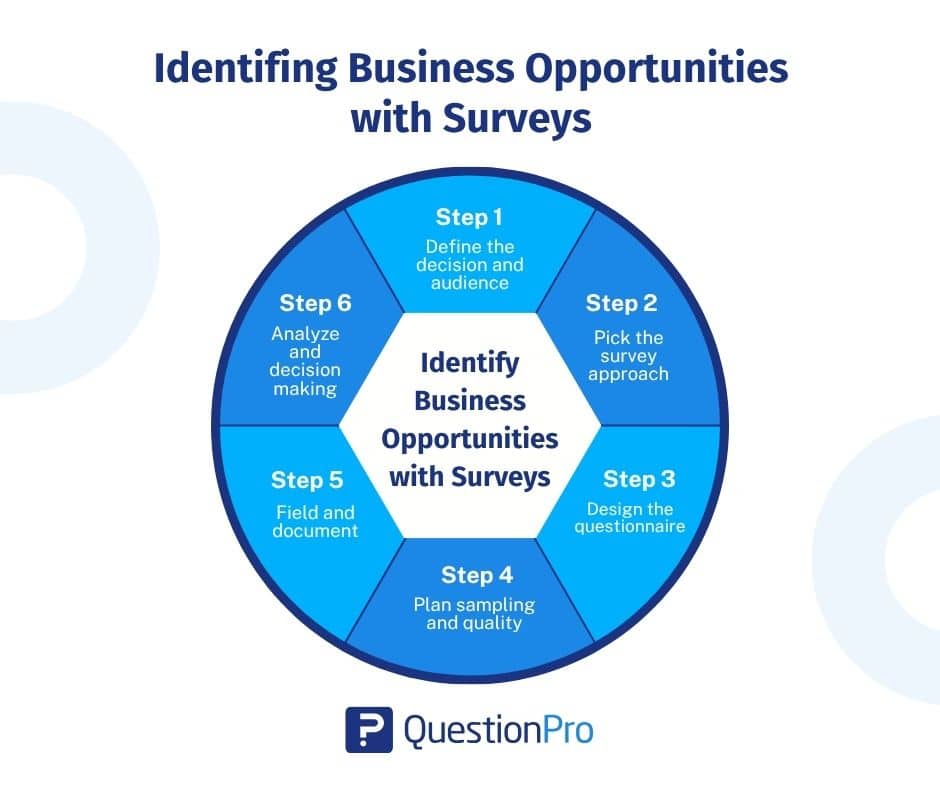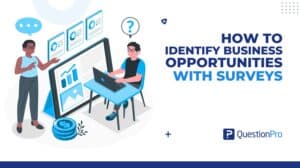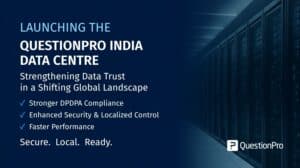
Great ideas are everywhere. Market research surveys help you to understand how to identify business opportunities with evidence, not guesswork. By asking clear questions to the right people, you can see where needs are unmet, where switching is likely, and where value is strong enough to support a real offer.
Surveys make signals comparable. You can measure problem frequency, impact on outcomes, satisfaction with current workarounds, interest in new concepts, and acceptable price ranges.
In this article, we’ll explain which survey types to use, what to ask, how to read the signals, and how to decide what to test next. Keep it practical, compare results across segments, and move from insight to action with confidence.
What are Market Research Surveys?
Market research surveys are powerful tools for uncovering unmet customer needs and identifying business opportunities. By gathering direct feedback from your target audience, surveys allow you to:
- Measure problem frequency and impact to identify the most pressing customer needs.
- Validate product concepts and features before committing resources.
- Assess pricing strategies and determine acceptable price ranges.
- Rank features, benefits, or messages to understand what matters most to your audience.
- Track trends over time to ensure your business stays aligned with evolving customer needs.
These insights help you make data-driven decisions that minimize risk and maximize growth potential.
Why Use Market Research Surveys to Identify Business Opportunities?
With a well-structured questionnaire, you can quantify need strength, estimate willingness to pay, and surface adoption barriers in a way that is repeatable across segments and over time. Professional standards from AAPOR and ICC/ESOMAR outline disclosure and design practices that make survey outputs auditable for product and go-to-market decisions.
Organizations that systematize customer evidence and analytics tend to outperform on core metrics such as revenue and profitability, underscoring the value of survey-driven opportunity identification.
When to prefer surveys over anecdotes
- You need to compare pains or concepts across roles, industries, or use cases.
- You must justify a roadmap or pricing decision with transparent, reproducible inputs.
- You’re feeding a discovery pipeline where evidence should accumulate wave to wave (quarterly or semiannually).
Surveys provide the methodological backbone for spotting, sizing, and de-risking opportunities, from unmet needs to pricing and adoption hurdles, in a way that can be inspected, replicated, and improved.
Which Survey Types are Ideal for Uncovering Opportunities?
Use a small toolkit. Each survey type answers a different question and produces specific evidence.
- Exploratory need-finding survey
This survey measures problem frequency, impact, and dissatisfaction with current workarounds. Use it to see which pains and segments deserve concepts or deeper study.
- Concept screening survey
This survey tests early ideas for clarity, relevance, uniqueness, and intent to try. Use it to decide which concept to refine or drop before investing more.
- MaxDiff for trade-offs
MaxDiff asks people to pick the most and least essential items in small sets. Use it to rank features, benefits, or messages with less rating bias.
- Pricing research
Van Westendorp finds an acceptable price range using four price-perception questions. Gabor-Granger measures purchase likelihood at specific prices to model demand and pick a starting price to test. Use Van Westendorp for early ranges and Gabor-Granger for demand and revenue.
- Adoption-barrier survey
This survey identifies hurdles such as compatibility, complexity, and trialability. Use it to target fixes in onboarding, integrations, or messaging.
These survey types provide a clear path from problems to decisions. You get comparable evidence across segments and time, which helps you identify business opportunities with less risk.
How to Identify Business Opportunities with Surveys: Step-by-Step Guide
This guide shows a simple way to turn survey responses into clear decision-making opportunities. You will define the decision, select the appropriate method, design focused questions, plan sampling, field the survey, and convert the results into the next steps.

Step 1: Define the decision and audience
Write the single decision your survey must inform. Specify your ideal customer profile and the segments you will compare.
Step 2: Pick the survey approach
Choose one primary method based on the decision. Use need finding for pain points and workarounds, and concept screening for fit and intent.
- MaxDiff for trade-offs.
- Pricing studies for acceptable ranges and demand.
Step 3: Design the questionnaire
Keep it short and focused. Include items on problem frequency, impact, satisfaction with current solutions, intent to try or switch, and one open question for what is missing.
Step 4: Plan sampling and quality
Create a sample plan that supports fair comparisons across segments. Keep the rules simple and make every step repeatable.
- Set segment quotas
- Add role and industry screeners
- Include recent behavior screeners
- Flag speeders and straight liners
- Detect duplicates
- Track source mix and response rate
Step 5: Field and document
Launch to your target sources and keep the median length reasonable. Record mode, dates, completes, and any weighting so results remain auditable.
Step 6: Analyze and decision making
Build simple indices such as a Need Index that multiplies frequency, impact, and dissatisfaction. Add MaxDiff utilities or pricing outputs if used. Compare by segment, rank with RICE, and log the next experiment, such as a prototype test, a fake door, or a pilot.
Review the outputs for each segment and document what you will do next. Keep your questionnaire, sample plan, and calculations in one place so the process is easy to repeat. Run the same steps in the next wave and compare results over time to confirm real opportunities.
Best Practices to Identify Business Opportunities with Surveys
Start with clear decisions and a focused audience to understand to identify business opportunities. Define what you need the survey to inform and who must answer it. Keep questions short, specific, and tied to the decision.
- Design practices: Screen for role, industry, and recent behaviors to reach the right people. Keep the survey brief to protect data quality.
- Evidence to collect: Measure problem frequency and impact. Ask about satisfaction with workarounds and the likelihood of trying or switching to other options.
- Methods to apply: Use need finding to map pains. Add concept screening for clarity and intent, MaxDiff for ranking, and pricing studies for ranges and demand.
- Sampling and quality: Set segment quotas for fair comparisons. Mix sources, tag them for bias checks, and apply quality controls for speeders and duplicates.
- Report analysis: Build a simple Need Index from frequency, impact, and dissatisfaction. Compare by segment, prioritize with RICE, and keep a versioned workbook.
Close the loop with a small test. Turn the top insight into a prototype, a fake door, or a pilot with a success metric. Document outcomes and repeat the same steps in the next wave to confirm real opportunities over time.
How to Identify Business Opportunities with QuestionPro Survey and Research
Creating an advantage in identifying business opportunities with QuestionPro surveys depends on having the right tools to design, target, and analyze feedback effectively.
QuestionPro provides an all-in-one platform that helps teams turn raw survey responses into clear opportunity signals. Here’s how it helps at every stage of the process.

- Ready-to-Use Survey Templates
Start fast with templates for need finding, concept screening, MaxDiff, and pricing. Each template maps questions to a clear decision, so signals roll up to action.
- Advanced question types for identifying business opportunities
Use MaxDiff to rank features or messages, Van Westendorp and Gabor-Granger for pricing, and conjoint for package trade-offs.
- Branching, logic, and randomization
Show only relevant questions, rotate concepts fairly, and avoid order bias. Clean design improves data quality and keeps surveys short.
- Multilingual and branding controls
Localize questions and keep a consistent look and feel. This improves comprehension and response rates across markets.
- Dashboards for segment and trend analysis
Slice results by role, industry, region, or source. Track waves over time to confirm which opportunities are persistent, growing, or fading.
- Text AI and theme tagging
Turn open-ended feedback into themes with sentiment and keywords. Tag pain-points and opportunities so qualitative input supports the same decisions as quantitative data.
- QuestionPro AI
QuestionPro AI helps simplify survey creation by automatically generating questions based on the needs. It saves time and ensures relevant, high-quality questions that align with your research goals.
Use these features together to run a repeatable workflow from questions to decisions. With a consistent process, you can prioritize the strongest opportunities and show how each choice is backed by survey evidence.
Conclusion
Identifying business opportunities works best when you rely on structured evidence. Surveys help you measure need strength, compare concepts, estimate price ranges and demand, and uncover adoption barriers in a way that is consistent across segments and over time.
Compared across segments and trended over time, these metrics give you evidence to guide roadmap, pricing, messaging, and go-to-market choices. Document the cycle, repeat the same steps in future waves, and confirm patterns before you commit resources.
Pair those insights with QuestionPro to close the loop. Use goal-aligned templates, MaxDiff, and pricing modules to collect the right data, apply quality controls, and segment dashboards to compare audiences, and export results to your prioritization model so every next step is backed by survey evidence.
Frequently Asked Questions (FAQs)
Answer: By asking about problem frequency, impact, and satisfaction with current workarounds, surveys quantify where pain is both common and consequential.
Answer: Use MaxDiff when you need a rank order of features, benefits, or messages without rating-scale bias. It forces trade-offs, so you see what is truly essential versus least important for each audience.
Answer: Van Westendorp identifies an acceptable price range from four price perception questions. Gabor-Granger tests purchase likelihood at specific prices to estimate demand and revenue curves for a starting price.
Answer: It quickly assesses clarity, relevance, uniqueness, and intent to try across audiences. Weak concepts are dropped early, and promising ones get refined before higher-cost testing.
Answer: Translate the top opportunity into a clear next step, such as a prototype usability test, a fake-door experiment, or a limited pilot. Define a success metric and log outcomes to inform the next survey wave.







